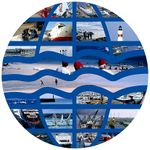Integrated Maritime Policy for the European Union
Contents
An Integrated Maritime Policy for the European Union -The Blue Book[1]
The European Commission launched a comprehensive consultation and analysis of how Europe relates to the sea. (See also the Green Paper for an EU Maritime Policy)
Building in this valuable input the Commission presented, on 10 October 2007, its vision for an Integrated Maritime Policy for the European Union, also called the Blue Book. This vision is based on the clear recognition that all matters relating to Europe's oceans and seas are interlinked, and that sea-related policies must develop in a joined-up way if are to reap the desired results
The Blue Book lays the foundation for the governance framework and cross-sectoral tools necessary for an EU Integrated Maritime Policy. It also sets out the main actions that the Commission will pursue, during the course of this mandate, in the following five action areas:
- Maximising the Sustainable Use of the Oceans and Seas
- Building a knowledge and innovation base for the maritime policy
- Delivering the Highest Quality of Life in Coastal Regions
- Promoting Europe's Leadership in International Maritime Affairs
- Raising the Visibility of Maritime Europe
A Governance Framework
An Integrated Maritime Policy requires a governance framework that applies the integrated approach at every level
Related actions by the Commission:
- invite Member States to draw up national integrated maritime policies, working closely with stakeholders, in particular the coastal regions;
- propose in 2008 a set of guidelines for these national integrated maritime policies and report annually on EU and Member States' actions in this regard from 2009;
- organise a stakeholder consultation structure, feeding into further development of the maritime policy and allowing exchange of best practices
Cross-sectoral tools
An integrated governance framework for maritime affairs requires horizontal planning tools that cut across sea-related sectoral policies and support joined up policy making. The most relevant tools are the following:
A European network for maritime surveillance -for the safe and secure use of marine space
Related actions by the Commission:
- promote improved cooperation between Member States' Coastguards and appropriate agencies
- take steps towards a more interoperable surveillance system to bring together existing monitoring and tracking systems used for maritime safety and security, protection of the marine environment, fisheries control, control of external borders and other law enforcement activities
Maritime Spatial Planning and ICZM -for sustainable decision-making
Related actions by the Commission:
- develop a roadmap in 2008 to facilitate the development of maritime spatial planning by Member States
A comprehensive and accessble source of Data and Information -for informed decision-making
Related actions by the Commission:
- take steps in 2008 towards a European Marine Observation and Data Network (building inter alia on the GMES initiative)
- promote the multi-dimensional mapping of Member States' waters, in order to improve access to high quality data
The Blue Book and Integrated Coastal Zone Management (ICZM)
The Blue Book recognizes that existing planning frameworks have a largely terrestrial focus and often do not address how coastal development may affect the sea and vice-versa.
In this regard, the Blue Book acknowledges that, following the EU Recommendation 2002/413/EC, Member States have begun to use ICZM to regulate the spatial deployment of economic activities and to set up spatial planning systems for Europe's coastal waters. Thus, the Blue Book proposes ICZM as a cross-sectoral tool -along with Maritime Spatial Planning - supporting joined up policy making in the integrated governance framework for maritime affairs.
As decision-making competence in this area lies with the Member States, the Blue Book states that what is needed, at the European level is a commitment to common principles and guidelines to facilitate the process in a flexible manner and to ensure that regional marine ecosystems that transcend national maritime boundaries are respected.
The Blue Book states that a system for exchange of best practice among authorities engaged in marine spatial planning and ICZM will be set up. However, it is important to note that it is not clearly acknowledged if this is one of the actions that the Commission will undertake.
Further reading
- See also EU coastal related policies
External links
Development of an Integrated Maritime Policy for the EU
EU Maritime Affairs Documentation Centre
References
- ↑ COM(2007)575 final, Brussels, 10.10.2007 -An Integrated Maritime Policy for the European Union -Communication from the Commission to the European Parliament, the Council, the European Economic and Social Committee and the Committee of the Regions
Please note that others may also have edited the contents of this article.
|

